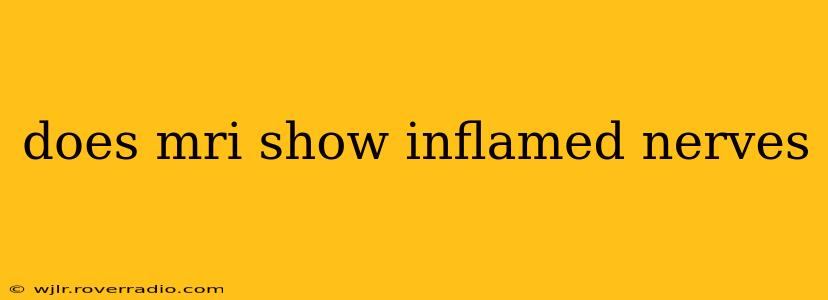Does an MRI Show Inflamed Nerves?
An MRI, or magnetic resonance imaging, scan is a powerful diagnostic tool used to visualize the internal structures of the body. While it excels at showing many soft tissues, the question of whether it can definitively show inflamed nerves is a bit nuanced. The answer is: it depends.
An MRI can indirectly detect nerve inflammation, but it doesn't directly "see" inflammation in the same way it might show a fracture or a tumor. Instead, MRI identifies the effects of nerve inflammation. This means that while an MRI might not highlight inflammation itself, it can reveal changes associated with it, helping doctors infer its presence.
What an MRI Can Show Regarding Nerve Inflammation
An MRI primarily focuses on visualizing the anatomy of the nerves and the surrounding structures. When a nerve is inflamed, several changes might appear on the scan that suggest inflammation:
- Changes in signal intensity: Inflammation can cause changes in the way nerve tissues appear on the MRI images. This is often subtle and requires a skilled radiologist to interpret.
- Nerve thickening or edema: An inflamed nerve might appear thicker than normal, or there might be swelling (edema) in the surrounding tissues.
- Changes in surrounding tissues: Inflammation often involves the tissues surrounding the nerve, such as muscles, tendons, or ligaments. The MRI might reveal abnormalities in these structures that suggest nearby nerve inflammation.
- Compression or entrapment: MRI can clearly show if a nerve is compressed or trapped, a common cause of inflammation (e.g., carpal tunnel syndrome).
What an MRI Cannot Directly Show
It's crucial to understand the limitations:
- Direct visualization of inflammation: MRI doesn't directly visualize the inflammatory process itself (like the presence of inflammatory cells).
- Subtle inflammation: Mild or early-stage nerve inflammation might not produce noticeable changes on an MRI.
- Differentiation from other conditions: Some MRI findings suggestive of nerve inflammation could also indicate other conditions, necessitating further investigations.
What Other Tests Might Be Needed?
Often, an MRI is used in conjunction with other diagnostic tests to confirm nerve inflammation. These might include:
- Nerve conduction studies (NCS): These tests measure the speed and strength of nerve signals, helping to pinpoint the location and severity of nerve damage.
- Electromyography (EMG): This test assesses the electrical activity of muscles and can detect muscle damage related to nerve inflammation.
- Physical examination: A thorough neurological exam by a physician is vital in evaluating symptoms and correlating them with imaging findings.
How a Doctor Uses MRI Findings
A skilled radiologist interprets MRI images and looks for subtle signs of nerve inflammation. They'll then provide a report to the referring physician, who will integrate this information with the patient's medical history, physical exam, and other test results to make a diagnosis. The MRI findings are a piece of the puzzle, not the entire picture.
Can an MRI Show Nerve Damage?
While not directly showing inflammation, an MRI can show the consequences of nerve inflammation, including damage such as:
- Axonal degeneration: Loss of myelin (the protective sheath around nerves) or damage to the nerve fibers themselves can be seen on certain MRI sequences.
- Atrophy: Wasting away of muscles due to nerve damage can be visible on MRI.
In summary, while an MRI doesn't directly visualize inflamed nerves, it can reveal indirect evidence of inflammation through changes in nerve appearance and surrounding tissues. Its role is best understood as part of a comprehensive diagnostic approach that includes other tests and a thorough clinical evaluation.
